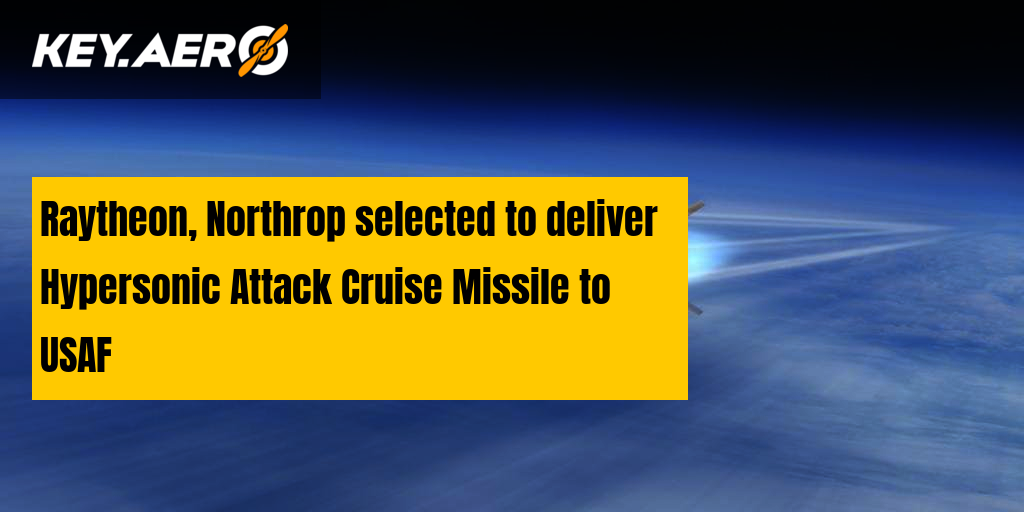Raytheon Missiles & Defense, in partnership with Northrop Grumman, has been selected to develop and deliver the Hypersonic Attack Cruise Missile (HACM) to the US Air Force (USAF).
The selection was announced on September 23, when Raytheon Missiles & Defense was awarded a $985.3m cost-plus-fixed-fee contract by the US Air Force Life Cycle Management Center’s Armament Directorate for the design, development and initial delivery of the HACM weapon system through the performance of model-based critical design review, qualification, integration, manufacturing and testing. Work under this contract will be performed at Raytheon’s facility in Tucson, Arizona, and is estimated to be completed by March 2027.

An early contractor derived artist rendering of the Hypersonic Attack Cruise Missile (HACM) in flight. Northrop Grumman
Wes Kremer, president of Raytheon Missiles & Defense, said: “Raytheon Missiles & Defense continues to be at the forefront of hypersonic weapon and air-breathing technology development. With advanced threats emerging around the globe, the HACM will provide our warfighters a much-needed capability.”
Envisaged as an air-breathing, scramjet-powered hypersonic missile, the HACM is described as a first-of-its-kind weapon, which is being developed in conjunction with the Southern Cross Integrated Flight Research Experiment (SCIFiRE) – a joint US-Australian project arrangement, which explores the development and testing of hypersonic cruise missile prototypes. As per the contract, the Raytheon Missiles & Defense and Northrop Grumman team will deliver operationally ready HACMs to the USAF.
Commenting on the HACM system, Gen Charles Q Brown Jr – USAF Chief of Staff – said: “HACM is a powerful example of developing and integrating combat capabilities alongside our partners from the beginning. HACM will provide our commanders with tactical flexibility to employ fighters to hold high-value, time-sensitive targets at risk while maintaining bombers for other strategic targets.”
As outlined above, this munition will be uniquely powered by an air-breathing scramjet engine. In short, such powerplants use high vehicle speed to forcibly compress incoming air before it is internally combusted. This allows for sustained flight at hypersonic speeds (or travelling at speeds greater than 3,000mph or Mach 5). “By travelling at these speeds, hypersonic weapons, like HACM, are able to reach their targets more quickly than similar traditional missiles, allowing them to potentially evade defensive systems,” Northrop Grumman explained in a press release on September 23.
Raytheon and Northrop Grumman have been working to develop, produce and integrate the latter’s scramjet engine technology onto the former’s air-breathing hypersonic weapons since 2019. Mary Petryszyn, corporate vice president and president at Northrop Grumman Defensive Systems, added: “The HACM creates a new class of strategically important weapons for the US military. Our scramjet propulsion technology is ushering in a new era for faster, more survivable and highly capable weapons.”

 www.key.aero
www.key.aero
The selection was announced on September 23, when Raytheon Missiles & Defense was awarded a $985.3m cost-plus-fixed-fee contract by the US Air Force Life Cycle Management Center’s Armament Directorate for the design, development and initial delivery of the HACM weapon system through the performance of model-based critical design review, qualification, integration, manufacturing and testing. Work under this contract will be performed at Raytheon’s facility in Tucson, Arizona, and is estimated to be completed by March 2027.
An early contractor derived artist rendering of the Hypersonic Attack Cruise Missile (HACM) in flight. Northrop Grumman
Wes Kremer, president of Raytheon Missiles & Defense, said: “Raytheon Missiles & Defense continues to be at the forefront of hypersonic weapon and air-breathing technology development. With advanced threats emerging around the globe, the HACM will provide our warfighters a much-needed capability.”
Envisaged as an air-breathing, scramjet-powered hypersonic missile, the HACM is described as a first-of-its-kind weapon, which is being developed in conjunction with the Southern Cross Integrated Flight Research Experiment (SCIFiRE) – a joint US-Australian project arrangement, which explores the development and testing of hypersonic cruise missile prototypes. As per the contract, the Raytheon Missiles & Defense and Northrop Grumman team will deliver operationally ready HACMs to the USAF.
Commenting on the HACM system, Gen Charles Q Brown Jr – USAF Chief of Staff – said: “HACM is a powerful example of developing and integrating combat capabilities alongside our partners from the beginning. HACM will provide our commanders with tactical flexibility to employ fighters to hold high-value, time-sensitive targets at risk while maintaining bombers for other strategic targets.”
As outlined above, this munition will be uniquely powered by an air-breathing scramjet engine. In short, such powerplants use high vehicle speed to forcibly compress incoming air before it is internally combusted. This allows for sustained flight at hypersonic speeds (or travelling at speeds greater than 3,000mph or Mach 5). “By travelling at these speeds, hypersonic weapons, like HACM, are able to reach their targets more quickly than similar traditional missiles, allowing them to potentially evade defensive systems,” Northrop Grumman explained in a press release on September 23.
Raytheon and Northrop Grumman have been working to develop, produce and integrate the latter’s scramjet engine technology onto the former’s air-breathing hypersonic weapons since 2019. Mary Petryszyn, corporate vice president and president at Northrop Grumman Defensive Systems, added: “The HACM creates a new class of strategically important weapons for the US military. Our scramjet propulsion technology is ushering in a new era for faster, more survivable and highly capable weapons.”
Raytheon, Northrop selected to deliver Hypersonic Attack
Raytheon Missiles & Defense, in partnership with Northrop Grumman, has been selected to develop and deliver the Hypersonic Attack Cruise Missile (HACM) to the USAF




